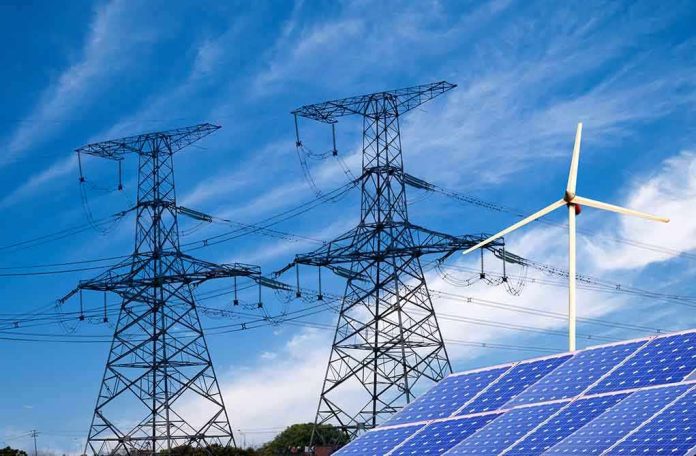
Americans could soon be facing up to 800 hours of blackouts every year by 2030, all thanks to years of reckless energy policies that sidelined common sense and put the grid at risk for the sake of green virtue-signaling.
At a Glance
- The Trump Department of Energy’s July 2025 report warns of an explosion in blackout hours if coal and gas retirements aren’t halted.
- Scheduled plant closures and a flood of unreliable renewables threaten the stability of America’s electric grid.
- AI data centers and manufacturing are driving electricity demand to new highs, just as reliable power sources vanish.
- The Trump administration is using emergency authority to stop the bleeding—reversing the “green agenda” to keep the lights on.
DOE Sounds the Alarm: Grid Reliability on the Brink
The Department of Energy’s July 2025 Resource Adequacy Report is not just another bureaucratic paper gathering dust. It’s a five-alarm fire bell, warning that Americans should brace for up to 800 hours of blackouts each year by 2030 if the country stays on its current path. This isn’t some distant, academic prediction. The report, ordered by President Trump’s Executive Order 14262, comes after years of accelerated retirements of coal and gas plants—pushed by green mandates and the blind worship of wind and solar. Meanwhile, the population and economy are demanding more power than ever, thanks to the rise of AI data centers and a manufacturing boom. The grid, once the envy of the world, is now teetering on the edge because reliable, always-on power has become a dirty word in the halls of the old D.C. establishment.
Let’s be clear: the DOE’s findings highlight that while 209 gigawatts of new power are supposedly coming online, only 22 gigawatts will be from dependable, around-the-clock generation. The rest? Intermittent renewables that vanish when the sun sets or the wind dies down. This is what happens when government bows to extreme environmental lobbies and treats energy policy like a science fair project. The report draws on NERC’s reliability assessments, which have been warning for years about these risks. But until now, no one in power seemed willing to admit that the emperor had no clothes.
Trump Administration Slams on the Brakes, Reverses the Green Surrender
President Trump and Energy Secretary Scott Wright are not mincing words or wasting time. The administration is invoking emergency authority to halt the scheduled retirements of critical coal and gas plants, warning that America cannot afford to “continue down the unstable and dangerous path of energy subtraction.” Secretary Wright has been blunt: if this country wants to keep the lights on, win the AI race, and prevent electricity prices from going through the roof, it needs to “unleash American energy”—not chase solar unicorns. The DOE is moving to end green energy subsidies and put a hard stop to the forced march toward unreliable power. New executive orders have been signed to prioritize dispatchable, American-made energy and to terminate clean energy tax credits and giveaways within 45 days of new legislation. It’s a radical change of course from the last administration’s obsession with decarbonizing at any cost, regardless of the consequences for ordinary families and businesses.
This isn’t just about politics—it’s about keeping the heat on in the winter, the AC running in the summer, and factories humming all year round. The alternative, as the DOE’s own data shows, is a future of rolling blackouts, skyrocketing bills, and the humiliation of watching America’s grid degrade into third-world territory. The administration’s critics may howl about climate goals, but the Trump team is betting that voters care a lot more about having reliable electricity than participating in international climate virtue-signaling. And who can blame them?
Who Pays the Price? The Real Impact on American Families and Industry
It’s not the climate activists or D.C. insiders who will suffer if this blackout apocalypse unfolds. It’s working families, small businesses, and the very industries that are supposed to power the next American century. Think about it: 800 hours without power in a single year is the equivalent of a month-long, nationwide outage. That means spoiled food, lost work, hospitals scrambling, and millions left literally in the dark. All of this, just so government can pat itself on the back for “leading the energy transition.”
The DOE’s report doesn’t sugarcoat it. If scheduled retirements of 104 gigawatts of reliable generation go through, and if new capacity continues to be overwhelmingly intermittent, blackouts will rise by a factor of 100 in just five years. The AI and data center boom—supposed to make America a tech superpower—could stall if the grid can’t keep up. Utilities will be forced to make hard choices, and consumers will foot the bill. The renewable lobby, meanwhile, faces a rude awakening as subsidies dry up and market realities bite. The administration’s intervention might be the only thing standing between order and chaos.







